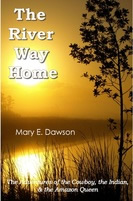Article first published as Book Review: Mary Dawson’s The River Way Home on Blogcritics.
May 23, 2013
The River Way Home:
The Adventures of the Cowboy, the Indian, and the Amazon Queen
Mary E. Dawson
WRB Publishing (2012)
ISBN: 9780985676254
New Novel Offers Escape into Florida’s Past with Three Unlikely Adventurers
 The River Way Home is the tale of three adolescents on the verge of adulthood as they embark on an adventure together through the Florida jungle in 1914. This unlikely trio is composed of Billy, an Okeechobee fisherman’s son who dreams of being a Florida cow hunter; Chief, a Seminole Indian; and Queenie, an African-American girl from Baltimore with a secret—she is descended from the Amazon Queens—and she will prove herself worthy of her ancestors before the novel is over.
The River Way Home is the tale of three adolescents on the verge of adulthood as they embark on an adventure together through the Florida jungle in 1914. This unlikely trio is composed of Billy, an Okeechobee fisherman’s son who dreams of being a Florida cow hunter; Chief, a Seminole Indian; and Queenie, an African-American girl from Baltimore with a secret—she is descended from the Amazon Queens—and she will prove herself worthy of her ancestors before the novel is over.
Queenie is a very inquisitive person who is always willing to share her knowledge. She quickly befriends Billy and the Chief, telling them how her parents and she have come to Florida to live, and wanting to know all about them. When the three decide to go out sailing and a storm comes up, landing their ship far from home, they find themselves on the adventure of a lifetime; while they plan to return home, they easily get distracted by the wonders of Florida, including a desire to see the ocean, and numerous obstacles get in their way including being attacked by an alligator and a panther, and having a run-in with the infamous outlaw, John Ashley, who, bent on revenge, will follow their trail. The places visited include the towns of Okeechobee, Tantie, and Stuart, as well as the Allapattah Flats. And Florida wildlife and marine life—catfish, alligators, panthers, and manatees—are all part of the experience that brings Florida’s past to life.
Dawson writes beautiful prose; she has an ear for creating intriguing dialogue and very readable dialect that add individuality to each character, and most of all, she develops characters you quickly grow to love and begin to think of as your friends. Queenie, as the strong central female character, especially reminds me of many of the brave Disney heroines and the novel has that sense of wonder and adventure without violence that the old Disney films of half a century ago had. I think anyone from age twelve onwards will find this novel delightful.
Being a fine historical and regional author, Dawson has also almost made Florida into a character in this book. She has captured the Florida frontier of 1914 as it was about to cease being a frontier, with the railroad coming and bringing with it a flood of tourists who enjoyed sport fishing and would waste its resources. Dawson depicts a Florida and its residents who want to hold onto its past, its uniqueness, its sense of identity against the unrelenting change to come. The result is a nostalgic novel with an environmental message that illuminates the book without distracting in any way from the fun.
An interesting historical note at the novel’s end reveals Dawson’s many influences from real-life people, including author Zora Neale Hurston, African Cow-Hunters, and early aviators. The River Way Home has captured the pioneer world of Florida in a way Willa Cather captured Nebraska’s and Laura Ingalls Wilder captured Minnesota and the Dakota’s past. As a reader who has only visited Orlando as one of the later day Yankee tourists the novel’s characters fear and know will change the world they love, I wished I could go back and visit this beautiful frontier world of a century ago in person, but at least I could take the journey through the pages of The River Way Home where the Florida frontier will live forever more.
The River Way Home is a novel to read slowly, to relish, to allow its sense of nostalgia, its depiction of a slower, gentler world, a slower pace of life, and people not afraid to be individuals, to take over as we are reminded that it is the journey, and not so much the end, that truly matters.
For more information about The River Way Home and Mary Dawson, visit www.MaryEDawson.com.
— Tyler R. Tichelaar, Ph.D. and author of the award-winning Narrow Lives

